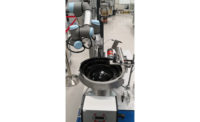Wires are rarely connected directly to an electrical or electronic assembly. There’s almost always a terminal of some sort crimped or soldered to the end of the wire to interface with a pin, post, connector or another terminal.
Wire terminals are produced in a vast array of shapes, sizes and materials. There are rings, hooks, spades, blades, pins and flags. There are quick disconnects and locking terminals. They can be made from brass or copper and given various platings and coatings. They can be supplied as loose parts or daisy-chained on a reel.
For most applications, it is not economically practical for connector manufacturers to design a terminal to accept one wire size, one wire stranding, and one insulation diameter. Most terminals accommodate many wire sizes, stranding, and a range of insulation diameters.
That’s important, because wire stranding and insulation type can vary widely even within one wire size. For example, there is more than 18 percent more material in an 18 AWG by 19-strand wire than an 18 AWG by 16-strand wire. The insulation diameter of an 18 AWG wire can range from 1.78 millimeters to more than 4.57 millimeters. Wire strands can be copper, tinned, over-coated or top-coated. Wire insulation materials, thickness, and durometers vary from application to application.
A wire terminal for crimping consists of a mating section, a transition section and a crimping zone. The mating section is the part of the terminal that mates with the other half of the connection. The transition section often contains stops or locking tangs that keep the terminal in place in the final product.
Also known as the barrel, the crimp section is the part of the terminal that is deformed during crimping. Some terminals have two barrels: one for the wire and a second for the insulation. This extra barrel gives the joint added strength. Some terminals have a stop at the end of the wire barrel. This prevents wire from passing completely through the barrel so the wire will not interfere with the function of the contact.
The Crimping Process
During crimping, the applicator die presses around the conductor with enough force to deform both the wire and the barrel, creating a cold weld between the two parts and establishing gastight connection. If done correctly, the terminal becomes an extension of the wire.
The undisturbed portion of the conductor barrel nearest the insulation crimp is known as the bell mouth. It acts as a funnel for the wires and reduces the possibility of a sharp edge on the barrel cutting or nicking the conductors.
In a good crimp, wire strands should protrude a minimum of 0.015 inch from the end of the crimp. All wire strands must be captured in the crimp ears during termination. Stray wire strands are not acceptable.
Both insulation and the conductors should be visible between the insulation crimp and the conductor crimp. The insulation crimp should surround the wire a minimum of 180 degrees without piercing the insulation. The insulation must not be caught in the wire crimp ears, because this will result in a poor electrical connection. The bell mouth should be visible, and the rest of the connecting end of the terminal should be undisturbed.
New Terminals
ETCO Inc. is now producing its twist lock terminals in loose piece form. In the past, ETCO had sold the terminals in carrier strip form only. Providing twist lock terminals in loose-piece form gives heavy cord manufacturers flexibility, enabling them to use the terminals as needed.
The availability of twist lock terminals in loose piece format also allows manufacturers to cut manufacturing costs. The ability to use both manual and automated equipment gives cord producers and harness shops a low-cost option when short runs of cord products are needed.
Twist lock terminals are constructed from 260 cartridge brass and accommodate several wire sizes. Featuring one crimp ear that can accommodate wire sizes from 10 to 16 AWG, they eliminate the need for tooling changes from one wire size to another. Male twist lock terminals are offered in NEMA L5-15P (125 V), NEMA L6-15P (250V) and NEMA L7-15P (277 V) configurations for molded electric power cords.
Molex Inc. has recently introduced a new line of crimp terminals for applications that require a high number of mating cycles, such as medical devices, consumer appliances, networking and telecommunications equipment, and power supplies.
Mini-Fit Plus HMC female crimp terminals are rated for up to 1,500 mating cycles and are capable of carrying up to 13 amps per circuit. Their elongated dimple design provides longer length and greater contact area when compared with standard Mini-Fit terminals, yet it does not increase the design dimensions of the product.
The terminal is available in wire-to-wire and wire-to-board configurations and comes in three wire gauge sizes: 16 AWG, 18 to 20 AWG, and 22 to 24 AWG. The terminals can be used with existing Mini-Fit receptacle and plug housings and with existing Mini-Fit and Mini-Fit Plus HCS headers. Additionally, because the crimp terminals are compatible with existing Molex crimp tooling, new tooling is not required.
Thomas & Betts is now producing its Sta-Kon plastic-bodied terminals as a continuously molded strip. This provides a more consistent surface than plastic strips that are welded together, which helps prevent equipment and tooling jams.
The funnel-entry design of the terminals enables fast and easy wire insertion. Internal barrel serrations increase conductivity and pullout strength. The sleeved barrels prevent separation that can diminish both pullout strength and dielectric performance.
“The continuous molding reduces downtime by not jamming equipment, as Mylar-tape systems are prone to do,” says Pam Pagenkopf, product manager at Thomas & Betts.
The terminals’ nylon insulation is UL94V2 flame rated and withstands operating temperatures of 221 F. The insulation also resists chemical exposure, impacts and abrasion. The UL-listed terminals have a maximum rating of 600 volts.
Mag-Mate insulation displacement connectors from TE Connectivity provide a cost-effective interconnect for manufacturers of fractional horsepower (FHP) motors. The terminals can be used on both copper and aluminum magnet wires.
“Many medium- and high-volume manufacturers of FHP motors for appliances and HVAC equipment are evaluating a switch from copper to aluminum magnet wire to reduce raw material costs,” says Fabrizio Longo, business development manager at TE Connectivity. “Copper contributes on average about 30 percent to the overall production cost of a FHP electric motor. Switching from copper to aluminum conductors can also reduce transportation costs, as aluminum is about one-third of the weight of copper. Our interconnection system allows manufacturers to easily and cost-effectively bridge the transitions many are making from copper to aluminum magnet wires.”
Aluminum conductors have approximately 61 percent of the conductivity and a small fraction of the tensile strength of their copper counterparts. Handling properties also differ, since aluminum lacks the resiliency of copper. The Mag-Mate IDC system compensates for these differences by providing two IDC slots that provide four gas-tight points of contact (two on each beam).
In addition, Mag-Mate connectors can simultaneously terminate two magnet wires of the same size in one terminal. IDC technology reduces assembly costs by eliminating soldering or stripping. The UL-recognized product terminates wire sizes ranging from 34 to 12 AWG. Product offerings include multiple lead wire attachment options and special versions that mate with RAST 2.5 IDC connectors.









